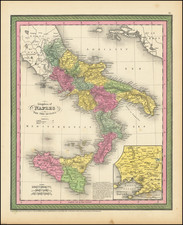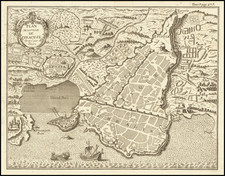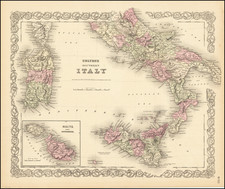Inside An Eruption of Mount Etna from the Mind of Athanasius Kircher
Situated on the east coast of Sicily, Mount Aetna, also known as Mount Etna, is one of Europe's most active volcanoes. Its eruptions have been recorded for millennia, with one of the most significant occurring in 1637. This eruption was not only crucial in the scientific community for its size and impact but also because it captured the attention of polymath Athanasius Kircher. His subsequent illustrations, particularly the "Typus Montis Aetnae ab Authore observati Ao. 1637," offer a fascinating insight into the 17th-century understanding of volcanology and Kircher's broader theories of the Subterranean World.
Kircher's illustration is striking in its unique perspective. Instead of a conventional depiction, the copper plate engraving displays a cross-section of Mount Aetna, revealing its inner workings, from bottom to top. This cut-away reveals a detailed system of channels and chambers, representing Kircher's interpretation of how volcanic eruptions come to pass.
The city of Catania, dwarfed by the Volcano, is strategically positioned in the foreground at the lower left, providing geographical context and scale. This urban depiction close to the volcanic action underscores the age-old human tendency to live near volcanoes for the benefits they offer, such as fertile land, despite the inherent dangers.
Kircher's exploration of the subterranean world was comprehensive for its time. His work touches on various subjects, from the speculative, like dragons, to the more concrete, like geothermal springs. While some of his theories might appear quaint or speculative today, they were grounded in the observations and knowledge available in the 17th century.
"Typus Montis Aetnae" is emblematic of a time when scientific inquiry was blending with artistic representation. Kircher’s work provides a snapshot of a period where humanity was taking significant strides in understanding the natural world, and Mount Aetna's 1637 eruption was a central point of fascination. This illustration, along with the rest of Kircher’s contributions, is a testament to the evolving understanding of the earth during a pivotal moment in scientific history.
Athanasius Kircher (1601-1680) was a Jesuit priest and a well-respected scholar known for his role in disseminating knowledge. Kircher was educated in Greek, Hebrew, and the humanities at Fulda, Paderborn, Cologne, Koblenz, and Mainz. After fleeing the Thirty Years’ War in Germany, Kircher worked as an academic at Avignon and, from 1634, Rome.
In Rome, Kircher served as an intellectual node, spreading information sent from around the world by Jesuit missionaries. Particular interests included ancient Egypt, astronomy, mathematics, medicine, music, and languages (both ancient and modern). He also made several maps and was a geographic compiler. It is likely he was the first person to depict the Pacific Ring of Fire on a map.
Kircher combined a mixture of hermeticism with nascent scientific inquiry, gaining him a reputation as one of the final Renaissance men. For example, he observed the eruptions of Etna and Stromboli. He had himself lowered into the crater of Vesuvius soon after an eruption to observe the changes wrought by the cataclysm. He experimented with bioluminescence by seeking the applications of firefly extract as a light source. He also made the first known Aeolian harp.
Kircher wrote 44 books, while over 2,000 of his manuscripts and letters survive. He also assembled one of the first natural history collections, the Museo Kircheriano or the Kircherianum, which was broken up after his death and became the foundation of several institutional collections.









![Elba [and] Sicilia](https://storage.googleapis.com/raremaps/img/small/66222.jpg)
![[ Sicily / Sardinia ] Septima Europe Tabula](https://storage.googleapis.com/raremaps/img/small/101893.jpg)



![[ Kingdom of Sicily, with Malta ] Carte De L'Isle Et Royaume De Sicile. Par Guillaume Delisle de l'Academie R. des Sciences. À Venise par P. Santini 1779.](https://storage.googleapis.com/raremaps/img/small/102161.jpg)